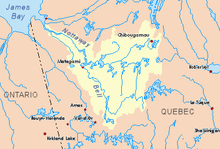|
Suzie River
The Suzie River is a tributary of the Mégiscane River flowing into the municipality of Senneterre in La Vallée-de-l'Or Regional County Municipality (RCM), in the administrative region Abitibi-Témiscamingue, in the province of Quebec, in Canada. The Suzie River crosses the townships Jalobert, Bourgmont, Bongard, Logan and Bernier. The course deviated by the dams flows rather in the canton of Brécourt via Lake Brécourt. The Suzie River flows entirely on forest land north-east of the La Vérendrye Wildlife Reserve and on the west side of Gouin Reservoir. Forestry is the main economic activity of this hydrographic slope; recreational tourism activities, second. The surface of the river is usually frozen from mid-December to mid-April. GeographyThe "Dictionnaire des Rivières et des Lacs de la province de Québec” (English: “Dictionary of Rivers and Lakes of the Province of Quebec”), 1914 edition, indicates that: "Susie, (River). - In the upper part of Saint-Maurice River. It flows, according to A. J. Lacoursière, A. G. (1912) through a slightly undulating and little forested country. The territory bordering it is almost uncultivated, and the woods that dominate are birch and cypress. His course is about 45 miles (72 km). It receives the waters of several lakes full of fish."[2]
The Suzie River rises at the mouth of Lake Boulevard (length: 0.85 kilometres (0.53 mi); maximum width: 0.3 kilometres (0.19 mi); altitude: 442 metres (1,450 ft) ). A mountain peak of 470 metres (1,540 ft) is located on the east side of the lake. This head lake is located at:
The mouth of Lake Boulevard is located at 50.6 kilometres (31.4 mi) south of the confluence of the Suzie River with Du Poète Lake (Mégiscane River) at 120.1 kilometres (74.6 mi) east of downtown from Senneterre, to 83.7 kilometres (52.0 mi) west of the village center of Parent and to 18.3 kilometres (11.4 mi) south of the Canadian National Railway. The main hydrographic slopes near the Suzie River are:
From the mouth of Lake Boulevard, the Suzie River flows over 71.4 kilometres (44.4 mi) according to the following segments: Upper Suzie River (segment of 14.1 kilometres (8.8 mi))
Suzie River Intermediate Course (segment of 30.3 kilometres (18.8 mi))
Lower Suzie River (segment of 27.0 kilometres (16.8 mi))
The Suzie River discharges on the west shore of Du Poète Lake (Mégiscane River) (elevation: 406 metres (1,332 ft)) which flows into a bend in the Mégiscane River. The latter is a tributary of Parent Lake (Abitibi). This latter lake flows into the Bell River, a tributary of Matagami Lake. The latter lake in turn flows into the Nottaway River, a tributary of the southeastern shore of James Bay. This confluence of the Suzie River with Lake Bernier is located at 30.7 kilometres (19.1 mi) north of the Canadian National Railway, at 31.7 kilometres (19.7 mi) north of the Susie River Railway Station, at 93.7 kilometres (58.2 mi) north-west of the village center of Parent, at 11.6 kilometres (7.2 mi) at the West of Gouin Reservoir and at 104.3 kilometres (64.8 mi) east of Parent Lake (Abitibi).HistoryIn 1948, the Government of Quebec approved the Shawinigan Water & Power Company project to raise the Gouin Reservoir, in order to increase the flow of the Saint-Maurice River and consequently increase the hydro-electric production. The Shawinigan Water & Power Company was able to carry out this project, by diverting the headwaters of the Mégiscane River and the Suzie River, which flowed naturally to the north, the James Bay, to make them flow south to the St. Lawrence River by the Saint-Maurice River. A series of dykes and canals have been built in these two rivers in order to carry out the diversion of the waters. ToponymyAccording to the Commission de toponymie du Québec, a first document, the name "Susie River" was approved on July 16, 1935, by the Quebec Geography Commission and according to a second, the name "Suzie River" was approved December 30, 1963. The toponym "Suzie River" was inscribed on December 5, 1968, at the "Bank of Place Names" of the Commission de toponymie du Québec, when it was created.[4] See also
References
External links |
||||||||||||||||||||||||||||||||||||||||
